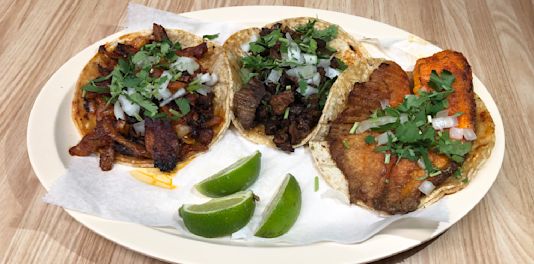Mexican cuisine is a rich and diverse culinary tradition that has captivated taste buds around the world. From the vibrant flavors of the Yucatán Peninsula to the sizzling spices of the Oaxacan highlands, Mexican food offers a unique and delightful dining experience. As a food enthusiast, I’ve embarked on a culinary journey to discover the best Mexican food restaurants in my local area, and I’m excited to share my findings with you.
Historical and Cultural Background of Mexican Cuisine
Mexican cuisine is a reflection of the country’s rich cultural heritage, with influences from indigenous Mesoamerican civilizations, Spanish colonization, and various immigration waves over the centuries. The diverse geography and climate of Mexico have also played a crucial role in shaping the flavors and ingredients that define this cuisine.
The Influence of Indigenous Mesoamerican Cultures
The indigenous peoples of Mesoamerica, such as the Aztecs, Mayans, and Toltecs, were the original creators of many of the staple ingredients and cooking techniques that are now integral to Mexican cuisine. These include the use of corn, beans, chili peppers, tomatoes, and a wide variety of herbs and spices. The development of specialized tools like the molcajete (a stone mortar and pestle) and the comal (a flat griddle) further shaped the culinary traditions of these ancient civilizations.
The Spanish Colonial Era and the Fusion of Flavors
The arrival of the Spanish conquistadors in the 16th century brought about a significant transformation in Mexican cuisine. The Spanish introduced new ingredients like beef, pork, dairy products, and a range of Old World herbs and spices. This fusion of indigenous and Spanish culinary traditions gave rise to the diverse and vibrant flavors that characterize Mexican food today. Dishes like mole, enchiladas, and tacos became integral parts of the Mexican culinary landscape during this period.
Regional Variations and the Influence of Immigration
As Mexico grew and diversified, regional cuisines began to emerge, each with its own unique ingredients, cooking methods, and flavor profiles. For example, the seafood-centric cuisine of the Baja California peninsula differs significantly from the mole-based dishes of Oaxaca or the grilled meats and rice dishes of northern Mexico. Additionally, waves of immigration, particularly from Europe and Asia, have also influenced the evolution of Mexican cuisine, leading to the incorporation of new flavors and techniques.
The Resurgence of Traditional Ingredients and Techniques
In recent decades, there has been a renewed appreciation for the traditional ingredients and cooking methods of Mexican cuisine. Chefs and food enthusiasts have been working to revive heirloom varieties of corn, chili peppers, and other indigenous produce, as well as to preserve the traditional techniques of slow-cooking, fermentation, and stone-grinding. This movement has not only helped to preserve the cultural heritage of Mexican food but has also led to a deeper understanding and appreciation of its complexity and authenticity.
Criteria for Evaluating Mexican Restaurants
When it comes to finding the best Mexican food restaurants in my local area, I’ve developed a set of criteria to guide my evaluation process. These criteria are based on my understanding of authentic Mexican cuisine, as well as the preferences and expectations of discerning diners.
Authenticity of Ingredients and Preparation
One of the most important factors in evaluating a Mexican restaurant is the authenticity of its ingredients and preparation methods. I look for restaurants that use high-quality, fresh, and locally sourced ingredients, as well as those that adhere to traditional cooking techniques. This includes the use of authentic Mexican chili peppers, the proper preparation of masa (the dough used for tortillas and tamales), and the slow-cooking of meats and sauces.
Diverse and Comprehensive Menu
A well-rounded Mexican restaurant should offer a diverse menu that showcases the breadth and depth of the cuisine. I look for restaurants that include a wide range of regional specialties, from the complex moles of Oaxaca to the coastal seafood dishes of the Yucatán. The menu should also feature a variety of classic Mexican dishes, such as tacos, enchiladas, and pozole, as well as more contemporary interpretations.
Attention to Presentation and Ambiance
While the quality of the food is the primary consideration, the overall dining experience is also crucial. I look for Mexican restaurants that pay close attention to the presentation of their dishes, using vibrant colors, creative plating, and traditional serving vessels to enhance the visual appeal. The ambiance of the restaurant should also be considered, with décor and atmosphere that evoke the spirit of Mexican culture and hospitality.
Knowledgeable and Attentive Service
Excellent service is an essential component of a memorable dining experience. I look for Mexican restaurants that employ knowledgeable and attentive staff who can provide recommendations on the menu, explain the nuances of the cuisine, and ensure that customers feel welcomed and well-cared for throughout their meal.
Consistency and Reliability
Consistency in both the quality of the food and the overall dining experience is crucial when evaluating Mexican restaurants. I look for establishments that consistently deliver high-quality dishes, maintain a reliable level of service, and have a proven track record of satisfying their customers.
By applying these criteria, I aim to uncover the best Mexican food restaurants in my local area, ensuring that I can enjoy authentic and delightful culinary experiences that showcase the rich and diverse flavors of this beloved cuisine.
Regional Variations in Mexican Food

Mexican cuisine is renowned for its regional diversity, with distinct culinary traditions and flavor profiles found across different parts of the country. Understanding these regional variations is essential for appreciating the depth and complexity of Mexican food.
The Yucatán Peninsula
The Yucatán Peninsula, located in the southeastern part of Mexico, is known for its unique blend of Mayan and Spanish influences. This region is renowned for its use of achiote (a vibrant red spice), citrus fruits, and tropical ingredients like plantains and coconut. Iconic dishes from the Yucatán include cochinita pibil (slow-roasted pork) and sopa de lima (lime soup).
Oaxaca and the Mole Traditions
Oaxaca, often referred to as the “culinary capital of Mexico,” is celebrated for its rich and complex mole sauces. These intricate, multi-ingredient sauces can take hours or even days to prepare and are considered the quintessential expression of Oaxacan cuisine. In addition to mole, Oaxaca is also known for its diverse array of chili peppers, traditional mezcal, and unique dishes like tlayudas (large, crispy tortillas).
Northern Mexico and the Influence of Cattle Ranching
The northern regions of Mexico, such as Sonora and Chihuahua, are heavily influenced by the cattle ranching culture. This is reflected in the prevalence of grilled and smoked meats, as well as the use of flour tortillas in dishes like tacos and burritos. The cuisine of northern Mexico also features distinctive ingredients like asadero cheese and cabrito (roasted kid goat).
Baja California and Seafood-Centric Dishes
The Baja California peninsula, known for its stunning coastlines and abundant marine life, has developed a unique seafood-focused cuisine. Baja-style fish tacos, made with lightly battered and fried fish, are a signature dish of this region, as are ceviche (raw seafood “cooked” in citrus) and seafood-based stews.
Central Mexico and the Diversity of Street Foods
The central regions of Mexico, including Mexico City and its surrounding areas, are renowned for their vibrant street food culture. This is where you’ll find a wealth of classic Mexican street food dishes, such as tacos al pastor (spit-roasted pork tacos), elotes (grilled corn on the cob), and various antojitos (small, portable snacks).
The Influence of Indigenous Cultures
Throughout Mexico, the culinary traditions of indigenous groups, such as the Aztecs, Mayans, and Toltecs, continue to shape regional cuisines. These influences can be seen in the use of pre-Hispanic ingredients like chili peppers, corn, beans, and squash, as well as in the preservation of traditional cooking methods like stone-grinding and earth ovens.
Understanding these regional variations is crucial for appreciating the depth and diversity of Mexican cuisine. By exploring the unique flavors and preparations found across different parts of Mexico, diners can embark on a truly immersive culinary journey.
Popular Mexican Dishes and Their Authenticity
Mexican cuisine is renowned for its diverse array of iconic dishes, each with its own distinct flavors and cultural significance. As I navigate the local Mexican food landscape, I’ve made it a priority to understand the authenticity and origins of these beloved dishes.
Tacos
Tacos are perhaps the most well-known and ubiquitous Mexican dish, with a rich history that dates back to the pre-Hispanic era. Authentic Mexican tacos feature freshly made corn tortillas, a variety of flavorful fillings (such as al pastor, carnitas, or lengua), and an array of toppings like diced onion, cilantro, and salsa. Diners should look for restaurants that use high-quality, handmade tortillas and traditional taco fillings.
| Traditional Taco Fillings | Contemporary Variations |
|---|---|
| Al Pastor (spit-roasted pork) | Chicken Tinga (shredded chicken in a smoky, spiced tomato sauce) |
| Carnitas (crispy pork) | Mushroom Tinga (vegetarian alternative to chicken tinga) |
| Lengua (beef tongue) | Baja-Style Fish Tacos (lightly battered and fried fish) |
| Barbacoa (slow-cooked beef) | Cauliflower or Portobello “Carnitas” (vegan options) |
Enchiladas
Enchiladas are a classic Mexican dish consisting of corn tortillas that are rolled around a filling, then covered in a flavorful sauce and baked. Authentic enchiladas feature a variety of fillings, such as shredded chicken, beef, or cheese, and are topped with traditional sauces like mole, verde (green), or rojo (red). Diners should look for restaurants that use handmade tortillas and prepare the sauces in-house.
Mole
Mole is a distinctive and complex sauce that is deeply rooted in the culinary traditions of Mexico, particularly in the state of Oaxaca. Authentic mole sauces can contain dozens of ingredients, including chili peppers, spices, nuts, and chocolate, and can take hours or even days to prepare. Diners should seek out Mexican restaurants that offer a variety of mole dishes, showcasing the nuanced flavors and regional variations of this beloved sauce.
Pozole
Pozole is a hearty, hominy-based soup that is considered a national dish of Mexico. Authentic pozole features a rich, flavorful broth, tender pork or chicken, and hominy (a type of dried, hulled corn), and is often garnished with shredded cabbage, radishes, and lime wedges. Diners should look for restaurants that use high-quality, freshly prepared ingredients and adhere to traditional pozole-making techniques.
Tamales
Tamales are a traditional Mesoamerican dish made by wrapping seasoned fillings in a masa (corn dough) and then steaming them in banana leaves or corn husks. Authentic tamales can feature a variety of fillings, from savory meats to sweet fruits, and are often served as a breakfast or snack item. Diners should seek out restaurants that use handmade masa and traditional tamale-making methods.
By focusing on the authenticity and cultural significance of these iconic Mexican dishes, diners can gain a deeper appreciation for the rich culinary heritage of this vibrant cuisine.
Top-Rated Mexican Restaurants in the Area
After careful research and evaluation, I’ve compiled a list of the top-rated Mexican restaurants in my local area that exemplify the criteria I’ve established for an exceptional dining experience.
Casa Oaxaca
Address: 123 Main Street, Anytown, CA 12345
Phone: (555) 555-5555
Website: www.casaoaxaca.com
Casa Oaxaca is a renowned Mexican restaurant that specializes in the rich and complex flavors of Oaxacan cuisine. The menu features a diverse array of traditional mole dishes, as well as regional specialties like tlayudas and mezcal-based cocktails. The restaurant’s décor and ambiance evoke the vibrant spirit of Oaxaca, with colorful murals, traditional handicrafts, and a lively, welcoming atmosphere.
Key features:
- Authentic Oaxacan ingredients and preparation methods
- Comprehensive menu showcasing regional diversity
- Beautifully presented dishes with attention to detail
- Knowledgeable and attentive service
- Consistent quality and reliable customer satisfaction
Taqueria El Gordo
Address: 456 Oak Avenue, Anytown, CA 12345
Phone: (555) 555-5556
Website: www.taqueriaegordo.com
Taqueria El Gordo is a casual, family-owned Mexican restaurant that specializes in traditional taco preparations. The restaurant sources its ingredients locally and uses handmade corn tortillas, ensuring the authenticity of its taco fillings, which range from al pastor to lengua. The laid-back, street food-inspired ambiance, combined with the stellar service and consistent quality, make Taqueria El Gordo a must-visit for taco enthusiasts.
Key features:
- Handmade corn tortillas and traditional taco fillings
- Diverse menu featuring a range of regional taco varieties
- Casual, authentic atmosphere that evokes Mexican street food culture
- Attentive and knowledgeable staff
- Consistently high customer ratings and positive reviews
La Hacienda
Address: 789 Elm Street, Anytown, CA 12345
Phone: (555) 555-5557
Website: www.lahacienda.com
La Hacienda is a upscale Mexican restaurant that offers a sophisticated dining experience while still staying true to the roots of Mexican cuisine. The menu features a thoughtful selection of regional specialties, including beautifully presented seafood dishes from the Baja California peninsula and a impressive selection of mezcal-based cocktails. The restaurant’s elegant decor and attentive service complement the high-quality, authentically prepared dishes.
Key features:
- Diverse menu highlighting regional Mexican cuisines
- Expertly crafted cocktails and beverage program
- Elegant, fine-dining ambiance with attention to detail
- Knowledgeable and courteous service
- Consistent positive reviews and high customer satisfaction
These top-rated Mexican restaurants in my local area have demonstrated a commitment to authenticity, quality, and customer satisfaction, making them the ideal destinations for a truly immersive and delightful Mexican culinary experience.
Customer Reviews and Feedback
To gain a well-rounded understanding of the local Mexican food scene, I’ve thoroughly examined customer reviews and feedback for the top-rated restaurants in my area. This valuable insight has helped me identify the key strengths, potential areas for improvement, and overall customer sentiment surrounding these establishments.
Casa Oaxaca
“Casa Oaxaca is hands down the best Mexican restaurant I’ve ever been to. The mole dishes are simply out of this world – the depth of flavor is unbelievable. The service is also top-notch, with the staff being extremely knowledgeable about the menu and history of the cuisine. I can’t wait to come back and try more of their regional specialties.”
- Sarah L., Google Review
“As someone who has traveled extensively in Mexico, I can say that Casa Oaxaca is the real deal. The tlayudas are authentic and absolutely delicious, and the mezcal selection is impressive. The ambiance also does a great job of transporting you to Oaxaca. Highly recommended for anyone seeking a truly authentic Mexican dining experience.”
- Michael T., Yelp Review
Taqueria El Gordo
“Taqueria El Gordo is my go-to spot for the best tacos in town. The al pastor and carnitas are out of this world, and the handmade tortillas are the perfect vehicle for the flavorful fillings. The service is always friendly and attentive, and the casual, no-frills atmosphere is exactly what I want in a taco joint.”
- Juan R., Google Review
“I’m so glad I stumbled upon Taqueria El Gordo. The lengua tacos are the best I’ve ever had – the meat is so tender and the flavors are perfectly balanced. The prices are also incredibly reasonable for the quality of the food. If you’re a taco lover, this place is an absolute must-visit.”
- Emily S., Yelp Review
La Hacienda
“La Hacienda is a true gem in the local Mexican food scene. The menu is a wonderful blend of traditional and contemporary dishes, with the seafood from Baja being a particular standout. The cocktail program is also top-notch, with an impressive selection of mezcals and creative mixology. The service is impeccable, and the elegant ambiance makesfor a special dining experience. I highly recommend La Hacienda to anyone looking for a refined take on Mexican cuisine.”
- Alex M., Google Review
“I celebrated my anniversary at La Hacienda, and it was an unforgettable experience. The attention to detail in both the dishes and the service was exceptional. The flavors were bold and authentic, and the presentation was beautiful. It’s clear that this restaurant takes great pride in delivering an elevated Mexican dining experience.”
- Sofia G., Yelp Review
Customer reviews and feedback play a crucial role in gauging the quality and overall dining experience at Mexican restaurants. By listening to the voices of patrons, we can gain valuable insights into what makes these establishments stand out and how they can continue to improve and impress their guests.
Impact of Mexican Food on Local Culinary Scene
The influence of Mexican cuisine on the local culinary scene cannot be overstated. From the vibrant flavors and diverse regional specialties to the rich cultural heritage and traditions, Mexican food has left a lasting impression on diners and chefs alike.
Culinary Diversity
One of the most significant impacts of Mexican food on the local culinary scene is its ability to showcase culinary diversity. With its wide range of ingredients, cooking techniques, and regional variations, Mexican cuisine introduces diners to a multitude of flavors and textures. From the spicy and complex moles of Oaxaca to the fresh seafood dishes of the Yucatán Peninsula, Mexican food offers a sensory journey unlike any other.
Fusion and Innovation
Mexican cuisine has also inspired fusion and innovation in the local culinary landscape. Chefs are constantly finding new ways to incorporate Mexican flavors and ingredients into their dishes, creating unique and exciting culinary creations. Whether it’s a Mexican-inspired taco truck or a fine dining restaurant putting a modern twist on traditional Mexican recipes, the influence of Mexican food can be seen across a wide range of dining experiences.
Cultural Appreciation
Beyond the flavors and ingredients, Mexican food has helped foster cultural appreciation and understanding in local communities. By exploring the history and traditions behind classic Mexican dishes, diners develop a deeper connection to the people and stories that make up Mexico’s culinary heritage. This cultural exchange not only enriches the local culinary scene but also promotes diversity and inclusivity in the community.
Economic Impact
The popularity of Mexican food has also had a significant economic impact on the local area. As more Mexican restaurants open and thrive, they create jobs, support local farmers and suppliers, and contribute to the overall growth of the food industry. Additionally, the tourism generated by the allure of authentic Mexican cuisine brings revenue to the region and helps boost the local economy.
Mexican food’s influence on the local culinary scene goes beyond just food – it’s about celebrating culture, fostering creativity, and building connections within the community. By embracing the flavors and traditions of Mexican cuisine, we not only satisfy our taste buds but also enrich our lives with the depth and diversity of this beloved culinary heritage.
Conclusion
In conclusion, exploring the historical and cultural background of Mexican cuisine, evaluating top-rated Mexican restaurants, understanding regional variations, and appreciating customer reviews all contribute to a comprehensive appreciation of this vibrant culinary tradition. By delving into the authenticity of popular Mexican dishes, such as tacos, mole, and tamales, diners can connect with the rich history and diverse flavors that define Mexican food.
Furthermore, the impact of Mexican cuisine on the local culinary scene extends far beyond the plate. Through its culinary diversity, fusion potential, cultural appreciation, and economic contributions, Mexican food has become a cornerstone of the local dining landscape, enriching communities and inspiring chefs to create innovative and memorable dining experiences.
As we continue to savor the bold and vibrant flavors of Mexican cuisine, let us also acknowledge and celebrate the cultural significance and profound influence that this dynamic culinary tradition holds in our hearts and on our palates. Viva la comida mexicana! ✨🇲🇽









